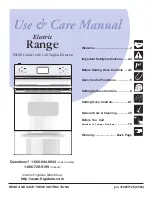
discoloration on the cooktop. Clean immediately before heating again or it may become
permanent. Check pots and pans for roughness that could scratch the cooktop before using.
Note: If pitting or indentation in the glass has already occurred, contact [email protected].
Damage from Sugary Spills and Melted Plastic
Take special care when removing hot substances from the cooktop to avoid permanent
damage to the glass surface. Unless removed while still hot, sugary spillovers (such as jellies,
fudge, candy, and syrups) or melted plastics can cause pitting of the surface of your cooktop
(not covered by warranty). When cleaning, be sure to use a new, sharp razor scraper. Do not
use a dull or nicked blade.
To clean sugary spills and melted plastic:
1.
Remove pot or pan. Turn off the cooktop and allow to cool.
2.
While wearing an oven mitt:
a. Use a single-edge razor blade scraper to move the spill to a cool area on the cooktop.
b. Remove the spill with paper towels.
3.
Leave any remaining spillover on the surface until the cooktop is cool.
4.
Do not use the cooktop again until you remove all of the residue completely.
Note: If pitting or indentation in the glass surface has already occurred, the cooktop glass
must be replaced. Contact [email protected].
Burned-on Residue
Note: Damage to your glass surface may occur if you use scrub pads other than ones
recommended for ceramic cooktops.
To clean burned-on residue:
Allow the cooktop to cool. Use ceramic cooktop cleaner and follow instructions on the
packaging.
To clean heavy, burned-on residue:
Use a single-edge razor blade scraper at 45° angle against the glass surface, applying
pressure to scrape and remove the residue. After you remove residue, use ceramic cooktop







































